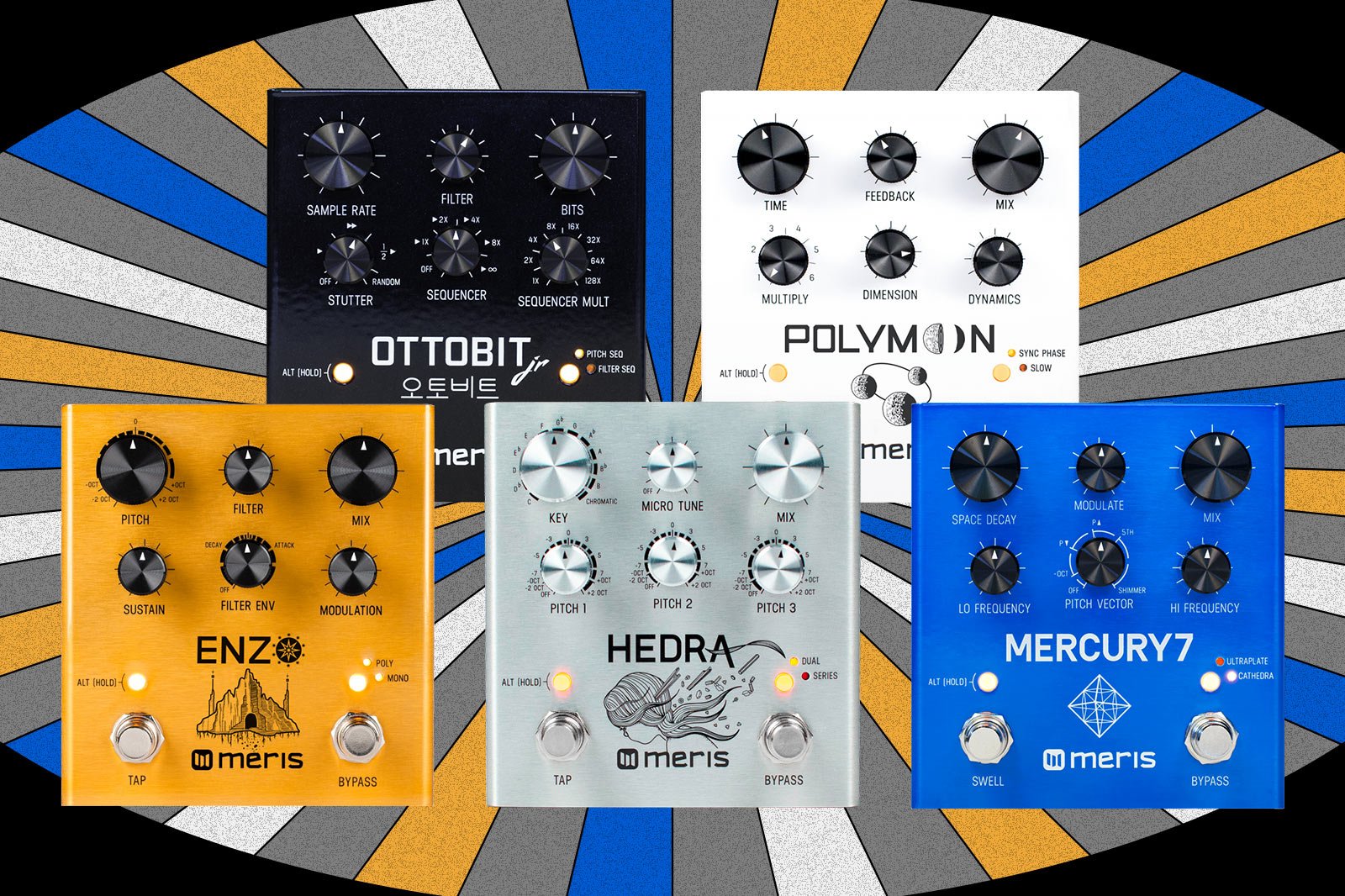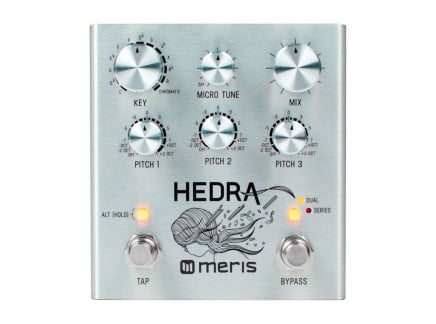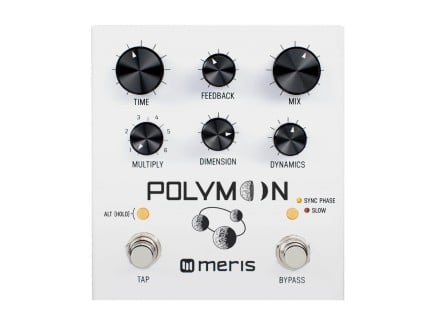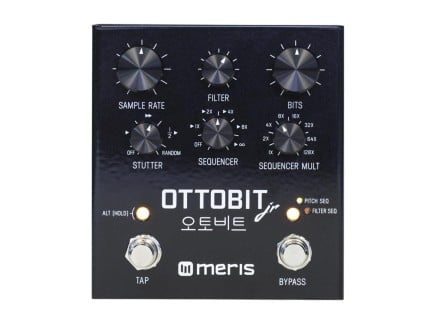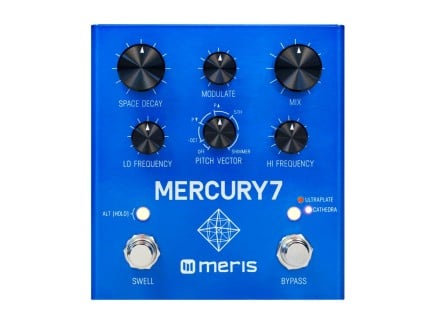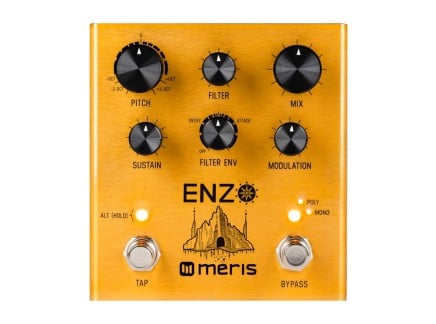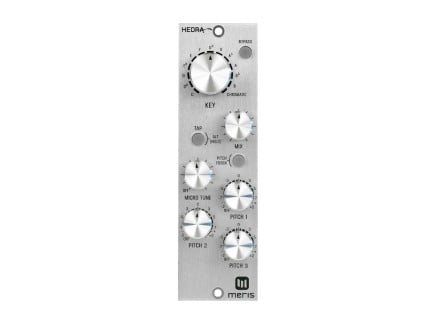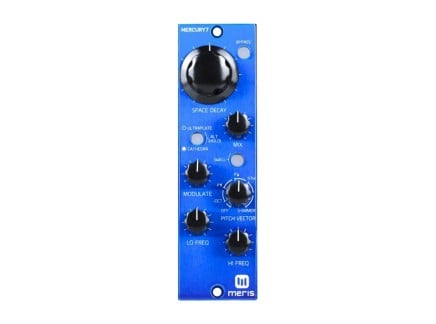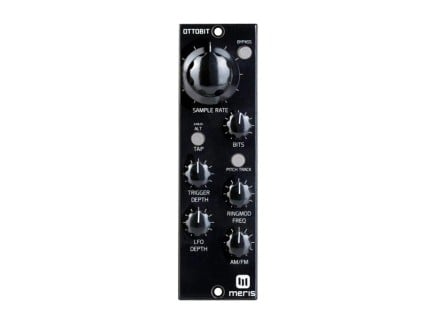If you're even tangentially interested in the world of effect processing, the odds are that you know about Meris: a company who is currently leading the charge in creating fresh new studio effects and effect pedals for guitar, synthesizer, and basically any other sound under the sun. Focusing on forward-thinking digital designs, Meris's effects expand on the traditions of classic studio effect processors, expanding their sonic potential significantly while maintaining a remarkable level of playability. If you're looking for some of the most interesting, forward-thinking effects available, you simply need to look at Meris.

Meris is in large part a partnership between hardware designer Terry Burton, DSP engineer Angelo Mazzocco, and branding expert/visual designer Jinna Kim. Each of them has a long history in the world of audio gear and effect design: Burton and Mazzocco met while working at Line 6, and Burton and Jinna famously founded Strymon—another continuing giant in the world of effect pedals. However, in 2013, Burton felt ready to start a new project...and thus, Meris was born. They began by producing 500 Series effect processors, but have since gone on to produce a series of remarkable effect pedals, always working from the basic design ideal of creating effect processors that feel and respond like musical instruments.
We at Perfect Circuit are obviously synth lovers, and lovers of electronic music in general—but what may not be apparent from an outside perspective is that many of us are also guitarists. As such, we keep a keen eye both on the universes of synthesis and effect processing, and are constantly seeking new ways to combine these worlds together. Given the strong sonic focus of each Meris pedal and the sheer playability of each design, we wanted to dedicate some time and space to describing what Meris's pedals do, how they sound, and what excites us about each one. So if you like unique takes on pitch-shifting delays, lush reverbs, or glitchy, rhythmic bitcrushing...you're in for a treat.
Studio Detuning and Evolving Rhythmic Harmony: Hedra
Chances are if you're a fan of delays and pitch shifters, then you might think the Meris Hedra is one of the coolest pedals in town. Terry Burton and Angelo Mazzocco, the driving brains behind Meris, attribute Hedra's design to their unabashed love for the rackmount harmonizers and effects processors of the 1980s and 90s—almost certainly units like the Eventide H3000, which we discussed in the first part of our Brief History of Eventide series. But Hedra grabs the best things about those legacy effects, and shrinks it down into a compact pedal package with a streamlined interface and host of modern niceties.
So then what is Hedra? At its simplest, it's a three-voice pitch shifter with key or chromatic quantization and lush chorus-like texturization with the Micro Tune control. But hold down the Alt button to access the secondary layer of parameters and tweak the Pitch controls to apply delay time offsets to each voice, unlocking its capabilities for sequencer and arpeggiator-like pitch movement. Suddenly, the simplest of melodies can be transformed into the dense harmonies and counterpoint with an otherworldly character to them. All delay times are based on divisions of the Tap Tempo for easy musical results, but you could also send MIDI Clock into Hedra (more on MIDI later). There's also a button above the bypass switch to change the delay and pitch shifter routing, opening up a number of different mono and stereo feedback configurations for different effect qualities.
That's hardly the full extent of what Hedra can do though, because the magic of this pedal is cracked right open with external control. Like all Meris pedals, expression pedals allow you to continuously morph between two parameter states for any and all controls across the full range of the pedal, including those on the Alt layer. Want to expressively dial in subtle or extreme amounts of Micro Tune? Easily done. How about sweeping through different musical scales as you play? Yep. You could set up an expression pedal to control any number of Hedra's parameters all at once.
But for the most creative options, Hedra supports extensive MIDI control capabilities. As mentioned above, you can send MIDI Clock from your DAW or any synthesizer (through something like the Meris MIDI I/O or Strymon Conduit to convert it from 5-pin DIN to 1/4" TRS), but you can also send individual CC messages to control every parameter individually. And because Meris wanted to make this thing as cool as possible, Hedra will also accept MIDI note messages to control the three pitch shifters, allowing you to pipe in chord progressions to repitch your playing in real time! The three voices are activated and muted with Note On and Off messages, respectively, so team up with a funky keys player and send their keyboard's MIDI output into the Hedra to explore weird gated, pseudo-vocoder sounds.
I could gush on and on about this pedal, but that goes to show that Hedra shines in nearly any musical context that you throw at it—we've used it with a bunch of guitars and synthesizers over the years, and for our friend Katrina Cain, it's a favorite on vocals as well. It's also totally valid as a creative studio tool, whether you're using it in its pedal form or 500-series module.
Swirling Repeats and Flooding Memories: Polymoon
The Meris Polymoon is not for the faint of heart: its majestic and alluring textures of multi-tap delay combine with spectacular modulation, diffusion, and pitch shifting to make a unique time-bending and spatializing effect like no other. Inspired by a host of classic rack effects, Polymoon captures a famed sound from the past, evolving it to work for any modern sound designer or performer looking for the cream cheese to their bagel—creating anything from lush pads to haunting echoes to deformed afterthoughts. I kid you not when I say that Polymoon will breathe new life into your creativity once you've spent time understanding the ins and outs of how the effect pushes and pulls your sound, no matter the source. Having an effect to complement and define the tone of your instrument or synths is one thing, but Polymoon stretches far beyond that. It all but asks you to play it as its own instrument—and of course, as with all Meris pedals, you can even set up presets to swap between for dynamic and lively performance.
Starting with the basics, Polymoon's central multi-tap nature is controlled by typical time and feedback controls as well as a multiply parameter, adding and spatializing up to six taps over time and space. Rhythmically, this is quite inspiring for creating dynamic and interweaving motives and harmonic progressions, but the introduction of the Dimension parameter begins to smear and diffuse the delays into a more reverb-like texture better suited for creating atmospheres and pads. That said, everything about Polymoon suggests both rhythmic and harmonic complexity, no matter if you're tapping in new tempos or performing a half-time slow-down by holding the tap footswitch. Alternative controls hidden behind the regular ones via the click of the ALT button allow you to not only shape the taps via a high/low filter tilt, but also to access the taps' complex network of modulation, divided into early and late taps. Six independent triangle LFOs provide a number of ways to apply subtle to extreme pitch-shifting modulation, from light vibrato/chorusing to intervallic harmony to gnarly FM tones.
Further on the modulation side of things, Polymoon has two accompanying internal effects for the multi-tap delay signal: barberpole phasing and dynamic flanging, both of which timbrally shift and enhance your initial creation. The phaser is engaged via the lit button above the bypass footswitch, producing either a slow 0.1Hz LFO modulation, a 1/4 note synchronized modulation, or a combo of both for intertwining phase-shifts. The dynamic flanger, on the other hand, injects anywhere from subtle vibrato-esque vibes to sweeping and undulating effects that play off your source audio with a vivacious and vigorous demeanor. The flanger can be customized via the alternative controls to shape the modulation via an envelope or an LFO…and furthermore, you can introduce negative feedback for a host of additional timbres.
Creating a simple yet bubbly patch on the Softpop 2, I find Polymoon quite adept and shifting from luxurious spaces and shimmers into treacherous, zooming and resonant booms that swirl around your head. You can even create this dichotomy on a preset by preset basis via an expression pedal or CV source by setting two different positions (heel-toe/0-5V), making it simple and performative to blend between two subtle or drastically different settings.
Burps & blips, sea-sick swirls, and flooding memories are all easy ways to describe how Polymoon can enhance your instrument…or of course, yo ucan simply use it to apply some much-needed stereo love to a monophonic synth. And on that note, it can be programmed to accept line-level and stereo audio, so don't be afraid to push your drums, samples, and synths through it as much as a typical guitar or bass. That being said, Polymoon plays well with any source material but predominantly likes to be toward the end of a chain as its dynamic and spectral density can reign superior in a signal chain.
Raw Destruction, Digital Dust, and Computer Error: Ottobit Jr.
Bitcrushing, sample rate reduction, pitch shifting, and filtering combine…and glitchy, raw, digital dust is what emerges from this gray box of fun: the Meris Ottobit Jr. Unlike some of their other pedals which have hidden ALT controls for sculpting your sound, the Ottobit Jr. eschews extra sonic control in favor of slipping a 6-step sequencer in the second layer. Since you don't really need to know what the sequencer does—or even use it—to have a good time, the pedal is perhaps a bit more approachable than their other offerings. You can easily stay on the top level and crush your audio, filter out the harshness, and add rhythmic glitch to your incoming signal and be quite happy. For those who want to dive a little deeper, though, you will not be disappointed.
Ottobit Jr.'s core is a bit-crusher and sample rate reducer, which can decimate your signal with musical finesse. A Moog-inspired low pass filter comes after the crushing, allowing you to add interesting sweeps or just dial back the resulting digital artifacts a bit. You also get controls for the glitch/stutter effect, which is tied to the tap-tempo control…imparting musical rhythm to the errors. You can choose whether glitches manifest as a normal-speed repetition, 1/2 speed repetition, or double speed. Additionally, there's a random option that will choose from the aforementioned, as well as adding reverse versions. The Stutter control moves from 1 instance of the glitch to 16 for each of the glitch options, making just a hint of glitch easily dialed in. The last two knobs control the sequencer, which lets the pedal live and breathe. The controls adjust the speed and how many times the sequencer will run once it begins. The sequencer is triggered by incoming audio, allowing for dynamic engagement of your preferred sequencing effect.
Yes. Sequencer. But How Do I Use It?
Like all Meris pedals, there is a second layer of functionality for each knob engaged by using the ALT button. For the Ottobit, that turns each knob into a value for the 6 steps of the sequencer. You can choose to either sequence the Pitch, Filter, or Sample Rate; while holding the Alt button, just adjust the knob to the desired amount and you're done. It's easy to use and simple to program, especially the Filter and Sample Rate sequencer. While the Pitch sequencer is incredibly powerful, it does require more work to dial in specific musical intervals. You have access to an octave up and octave down in chromatic intervals with the maximum being a step skip (CCW) and minimum, step silenced (CW).
The real joy is playing with the Ottobit, which is satisfying straight away: nothing terribly complicated, no handshakes to execute, just pure joy. By subtly adjusting the Sample Rate sequencer, you can get a nice bit of added character that is hard to place and entirely unique or add 8-bit video game sounds with ease. Wild changes in the Filter Sequencer, with the Sequencer Mult up very high can yield squishy, bubbly sounds—or alternatively, you can easily get your computer glitch effects going with Pitch Sequencing. There's more to this pedal when it is used in your own unique way and integrating this into your workflow is a wholly satisfying experience.
Like the other Meris pedals, you also have an expression pedal input that lets you morph between two sets of knob positions, including the sequencer positions. Evolve your sequence melodically, create a bit crushed wah effect, create on-demand stutter effects, or anything in between. The Ottobit Jr is best viewed as a tool for precise sonic destruction, subtle distressing, or mild digital artifacting. Try it once and you will be hooked. (And don't forget—Ottobit Jr. is the descendant of the still-available Ottobit 500 Series rack effect!)
Endless Spaces and Time Unraveling: Mercury 7
Providing a modern-day take on the expansive, spacious sounds of Vangelis's Blade Runner soundtrack and classic Lexicon reverb units, Mercury 7 is a powerful reverb processor with an enormous sonic range. Originally available as a module for the 500 Series format, Mercury 7 is now also available as a powerful stereo effect pedal...bringing lush sonic spaces to countless pedal boards.
Mercury 7 features two algorithms with their own distinct character: Ultraplate and Cathedra. Naturally, both algorithms feature the types of controls you'd expect to see on a reverb: mix, EQ, and decay (up to infinite decay!). But there's much more to it than that: Mercury 7 also incorporates internal modulation, clever pitch shifting effects, a triggerable Swell function, and (like all Meris pedals) a host of ALT functions that extend its functionality well beyond what its front panel presents. ALT functions include pre-delay, mix for the pitch shifting function, modulation speed, an internal vibrato function, swell envelope duration, and reverb density...making for a huge range of sonic options despite its compact format.
As you might expect, the Ultraplate algorithm is an extended model of a plate reverb—making for vast, diffuse reverberation that sits comfortably in a mix. This setting is an ideal choice for building textures without clutter...you can even easily use it with dense input material from drum machines or full mixes without it getting sonically overwhelming. The Cathedra algorithm is an extended model of a physical space, like a vast cathedral with beautiful trailing reverberation; reverb tails extend naturally, almost as if they're dripping off of the input sound.
One of Mercury 7's most interesting features is the Pitch Vector parameter. Pitch Vector inserts a pitch shifter in the reverb network's feedback loop, creating reverb smears that drift up or down in pitch over time. The speed and intensity of this smearing effect can be controlled in part by tuning the reverb decay, while the pitch vector parameter determines what musical interval is used for the shifting function. This includes a number of pre-set intervals—Shimmer (octave up), 5th (a fifth up), P^ (a slight upward shift), Pv (a slight downward shift), and -Oct (octave down). Octave and fifth intervals will create blooming, cascading harmonies, but the P^ and Pv settings will produce more peculiar, gradually shifting, even discordant results. This enables everything from grand, cathartic evolutions all the way to eerie, unsettling, constantly decaying textures.
One of the other particular interesting features is the Swell footswitch, which can be used to gradually ramp the Decay parameter up to infinite repeats (with user definable ramp time). This can be a great way of injecting performative control...for instance, your default setting could feature a very short decay time, with the Swell switch very suddenly engaging infinite repeats in order to act like a pseudo "Freeze" control...but one with an internal pitch shifter for constant timbral evolution (!!!). And of course, the internal modulation means that the nature of the space itself can fluctuate, creating sonic disruptions to the internal feedback path for warbling, shifting sonic spaces.
And of course, like all other Meris pedals, Mercury 7 comes to life with external control. You can connect an external MIDI controller, preset footswitch, or even just a simple expression pedal. As with their other offerings, users can define heel down/toe down states for the expression pedal, allowing morphing between two vastly different reverb settings. Combined with the Swell switch, this makes for an uncommonly playable reverb...an effect where space and time can bend and become a truly expressive, integrated part of your playing. Mercury 7 is one of the finest reverb processors available, period.
A Synthesizer in Disguise: Enzo
There have been a lot of guitar synth pedals over the years, from long-standing favorite Electro-Harmonix Micro Synth to cult classics like Boss's SYB-5 to the now-discontinued Digitech Synth Wah. Each one takes a different approach to a very open-ended topic—after all, there's no one way to make a guitar sound like a synthesizer. When you emark on that endeavor, you have to make a lot of decisions—how are the raw waveforms generated? How are they processed? And of course, given the fact that most synthesizers have a larger number of sonic parameters than the average guitar pedal, a number of other questions arise: how many parameters do you give to the player? How can you make for a flexible sonic experience without overwhelming the user?
Many guitar synths of the past took the relatively simple approach of using a quite simple sound structure with a minimal number of variables, and yet others rely instead on a large selection of pre-set sounds with a couple of variable parameters each...rendering the realm of guitar synthesis a novelty more so than an approach that players could rely on as a foundational aspect of their instrumental practice. In many ways, Enzo corrects this—rather than simply being a stripped-down tool for making your guitar sound like a synthesizer, it's fairly easy to see Enzo itself as a synthesizer...just one that foregoes a keyboard or sequencer in favor of using external audio as a control method.
Unlike most guitar synth pedals, Enzo gives the player direct access to a huge number of distinct sonic ingredients, each with their own continuously variable controls...making for an uncommon degree of flexibility. Enzo's synth engine contains four synthesis modes (which I'll describe momentarily), with two oscillators per voice, six filter modes, an envelope generator, envelope follower, a multi-tap digital delay, pitch shifter, tremolo/ring modulator, and a load of additional options for sound sculpting and control.
The four synthesis modes in Enzo each provide a distinct sound-world ripe with potential. Mono mode is designed to create heavy bass sounds and soaring leads. The Poly mode is designed for polyphonic tracking, making it easier to accomplish classic synth pads and stabs. "Dry" mode foregoes the internal oscillators, in favor of pitch shifting for your instrument's dry signal, turning Enzo into a particularly interesting multi-effect. And then, there's one of Enzo's most unique options: the Arp mode, in which incoming chords are translated into synth arpeggios (yep, it's an arpeggiator for your guitar!).
Each mode uses a similar feature set—giving you the ability to vary the synthesizer's pitch (relative to your incoming signal), its filter cutoff frequency, its filter envelope shape, sustain duration, and a wet/dry mix between your dry sound and the synthesized sound. Holding the ALT button provides access to a number of other parameters—oscillator wave shape selection, access to the internal digital delay (with dual-tap functionality), a ring modulator, portamento control, and envelope follower control. The envelope can be routed to the filter, pitch, and ring mod carrier frequency, and, like all other Meris pedals, you can use an expression pedal to continuously morph between two completely different states.
Inspired by the sounds and behaviors of classic vintage synthesizers, Meris packed a tremendous amount of flexibility into this pedal, with an approach that remains surprisingly intuitive despite its complexity. It's a strong testament to Meris's design brilliance that they can create an effect that truly transcends the capabilities of its predecessors while remaining accessible and, most importantly, fun. It's impossible to describe everything Enzo can do in a few short paragraphs...but suffice to say that, despite its simple appearance, Enzo isn't just a synth effect. Enzo is a synthesizer all its own.
Effect Processors as Musical Instruments
An effect processor can be much more than a simple set-and-forget affair. Instead of thinking of effects as an extra layer to add onto a sound, the right effects can shift your perspective entirely: effect processors can become a part of your instrument, expanding the way you play, nudging you into new musical directions, and becoming an intrinsic part of your personal sound. Of course, this type of symbiotic relationship between player and effect isn't a given: some effects lend themselves to this type of thinking more so than others. Take Hedra or CXM 1978 (a collaboration with Chase Bliss), for instance—these are devices that can easily become a part of how you performatively interact with sound.

Every Meris effect can do this. By re-thinking classic processing schemes and expanding them significantly, each Meris effect can make a huge range of sounds suited to an equally huge range of musical styles. Every single one of them can be ugly, menacing and brash; and of course, every single one of them can just as easily be ethereal, gentle, and calming. What's more, Meris's attention to extensive MIDI control, preset storage, performative user interfaces, and clever expression pedal control means that it's possible to take each pedal in a drastically different direction at a moment's notice. After a little bit of time exploring and practicing, shifting between sound worlds can be just as intuitive and perfomative as changing chords on your guitar, or changing patterns on a drum machine. When we say that Meris pedals are like musical instruments, we truly mean it: they have the sonic range you need, and the ability to turn on a dime to remain appropriate in any musical scenario. Like any instrument, this type of facility requires commitment and practice on the part of the player...but from my perspective, any device that warrants this level of attention from a player is a device well worth diving into.

